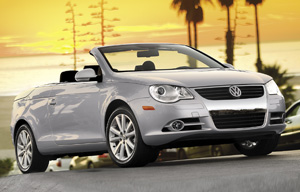
ATHENS – A new day is dawning at Volkswagen AG, so it’s fitting that the auto maker’s most innovative vehicle for 2006 is named for the goddess of the rising sun.
The Eos seats four (two comfortably) beneath the industry’s first retractable hardtop with an integrated glass sunroof. Volkswagen calls it a CSC, short for coupe-sunroof-convertible.
Will it blow the roof off the convertible market? No.
But its target customers will flip their lids – despite the relatively rich starting stickers of $27,990 for the base model powered by a 2L turbocharged 4-cyl., and $36,850 for the top-end 3.2L FSI V-6 fronting 250 hp and VW’s super-slick DSG (Direct-Shift Gearbox) automated manual transmission.
VW is leveraging the attributes of its lively, direct-injection gasoline I-4 – a Ward’s 10 Best Engines winner for 2006. It also drives the hot-handling '06 GTI.
Volkswagen has targeted initial U.S. volumes between 10,000 and 15,000 units because, like the goddess for whom it is named, the Eos likely will not immediately connect with throngs of mere mortals. Expect it to resonate mainly with VW aficionados and tech geeks, because they know what usually lies beneath the brand’s understated exteriors.
The Eos is not unlike those mischievous Greek gods who donned disguises so they could mingle with humans. With its predominantly flat surfaces, the car almost is dowdy with its roof up.
But with its top dropped, the Eos looks sporty and elegant. The decklid, which is elevated slightly to house the Webasto AG-supplied 5-panel folding roof, exaggerates the dramatic rake of the car’s beltline.
To fully appreciate the sophistication of this unique new roof, you’ve got to get down with it.

The console-mounted switch causes the sunroof section to slide backwards as the entire rear section, from the C-pillar to the point where the B-pillar would be located, lifts up.
The sunroof section slides under the roof’s rear portion, stacking the panels like a sandwich as the hard tonneau cover raises. Simultaneously, the decklid tilts up and back to expose a shelf in the trunk.
The stacked roof panels are positioned atop this shelf, beneath which remains 7.2 sq.-ft (0.2 sq.-m) – enough room for two moderately sized pieces of roller luggage. With the roof up, the car’s trunk offers 13.4 sq.-ft. (0.4 sq.-m) of storage.
A sensor sounds a warning and prohibits operation if there is less than the required 20 in. (50 cm) of clearance to accommodate the decklid’s movement.
Meanwhile, the lateral roof spars – jutting out like the tines of a fork – slide back and down into their own space beneath the hard tonneau cover.
All this is accomplished in just 25 seconds. While these gyrations are somewhat frantic and less graceful than the 3-panel retractable hardtop featured on the similarly sized Volvo C70, the mechanism is exceedingly quiet.
Quiet also is what you find in the car’s interior – roof up or roof down. However, the glass sunroof suffers from a pair of quirks.
First, the screen that prevents wind buffeting in the cabin must be manually deployed – a trade-off for the CSC’s overall complexity, VW says. Moreover, its activation switch requires bothersome fiddling to distinguish the tilt and slide functions.
But VW hardly has a monopoly on this problem.
The Eos interior is what you expect from VW. It is neat, tasteful, well executed and carefully conceived.
For instance, the door panels feature gentle folds that extend lines originating on the vehicle’s exterior. The result is a cleverly derived harmony between the subdued sheet metal and the car’s sporty cockpit.
The well-insulated cabin reduces the 4-banger’s exhaust note to a gentle hum occasionally punctuated by the turbo’s reassuring whir. But its soft voice belies the car’s true nature.
Inspiring and refined, the ride quality is strikingly smooth. Still, there is nothing mushy about the Eos – except, perhaps, its seat bolsters.
Sadly, VW panders to the lowest common denominator by planning to equip its American-spec models with “comfort seating,” eschewing the firmness favored by Europeans.
The car’s front-wheel-drive sure-footedness is rooted in its well-balanced engine, ample 61-in. (155-cm) track width, and the stiffness afforded by high-strength steel in the A-pillars and floor crossmembers.
Tie all this down with a McPherson-strut front suspension borrowed from the Golf, and a 4-link rear setup copied from the Passat, and Eos stands capable of mythically proportioned road-hugging ability. For a convertible.
On narrow, ascending switchbacks outside this ancient city, the Eos – aided by its well-tuned steering – stays reassuringly flat.
But in the shadow of some ruins named for the Greek god of the sea, the car’s electronic stability control flashes incessantly when the driver attempts to apply the power. The immediate suspicion is too-cautious calibration, or the wrong rubber.
But locals explain the searing Mediterranean sun brings out the worst in the paving compound used on their roads, leaving them slick as olive oil and making the stability-control system struggle to make sense of the meager traction.
Needless to say, the fist-friendly shifter never stayed long in the top slot of the test car’s 6-speed manual.
Not all is lost, however, because Eos’ torquey, low-gear performance is easily managed by its responsive throttle.
Cheeky Volkswagen insiders quietly note that Eos, the goddess, had an affair with the beau of Aphrodite, deity of love. So, according to ancient texts, Aphrodite smote Eos with a curse that left her “tormented with constant passion.”
VW’s all-new convertible is good. But it’s not that good.




